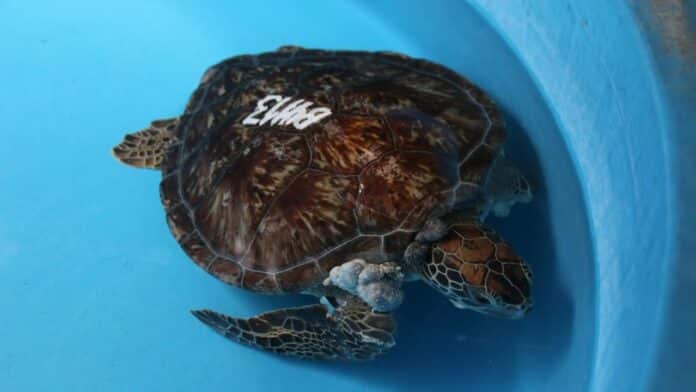A new study in eastern Brazil looked at young green sea turtles, which are in danger of disappearing. The study found that water temperature, saltiness, and being close to environmental problems could make these turtles more likely to get a disease with tumors caused by a virus.
Researchers from the University of California-Davis, did this study and shared their findings in a journal called PLOS ONE. They also learned that where these tumors appear on a turtle’s body might help us understand the disease better.
This disease is called fibropapillomatosis, or FP, and it was first noticed in 1938. But in the 1980s, there was a significant increase in cases. This disease can affect all sea turtles, but young green sea turtles get it the most, and it’s worse for them. These tumors grow on their neck, eyes, flippers, and limbs but don’t go inside the body. Still, they can make it hard for the turtles to eat, swim, and do other things.
Even though a virus called Chelonid herpesvirus 5 causes this disease, not all turtles with the virus get it. The tumors are more common in young turtles living near cities, making researchers think that where they live might affect the disease.
“Just having the herpesvirus is not enough for the disease to show up, so we need to figure out what else might be causing it,” said Uhart.
To understand this better, researchers from UC Davis and some experts in Brazil looked at how this disease happens in green turtles on the coast of Espírito Santo, Brazil. In this place, lots of turtles get these tumors – more than 40% of them.
One reason why this happens a lot in Espírito Santo might be because of factories that make metals. They send warm water into the sea, and young turtles like warm water. Surveys underwater found that almost 76% of turtles in those areas have tumors.
The researchers looked at two sets of data: one about turtles that got stranded or died on the beach over four years and another about tumors in 271 turtles in the same place.
They found that turtles with marine leeches, which might spread the herpes virus, were four times more likely to get tumors. It looks like lots of things, like how old the turtle is, how healthy it is, and things in the environment (like how salty the water is, how warm it is, and being near metal factories) can increase the chances of getting tumors.
The researchers also noticed three different ways this disease shows up: the tumors can be on the front flippers, back flippers, or other parts of the body. The environment also influences these patterns.
Ralph Vanstreels, who led the study, said, “Having these clear patterns in different parts of the turtle’s body, which are connected to the environment, makes us think that this disease might be more complicated than we first thought.”
The study suggests that by looking at where the tumors are on the turtle, we might learn more about what caused them, like things about the turtle itself and things in the environment.
Researchers have been trying to figure out why this disease is more common in some places than others. However, different studies didn’t agree on one main reason. This study suggests that there might be various reasons for different types of this disease.
Uhart said, “If things keep going this way, sea turtles might not get healthier, but sick. These problems are connected to big changes happening worldwide.”
Sea turtles have been around for more than 150 million years. They’re essential in the ecosystem because they eat and carry nutrients and are hunters and hunted by other animals. “We have to protect these turtles to keep our oceans healthy. Understanding why more of them are getting this disease is a big part of the puzzle,” Uhart added.
The study’s findings indicate that understanding how tumors are distributed on a turtle’s body can provide insights into the factors that trigger tumor growth. FP is a complex disease influenced by individual and environmental factors. Protecting sea turtles is vital for ocean health, and investigating the recent increase in FP cases is essential to this effort.
Journal Reference:
- Ralph E. T. Vanstreels, Alexis Durant, et al., Exploring the relationship between environmental drivers and the manifestation of fibropapillomatosis in green turtles (Chelonia mydas) in eastern Brazil. PLOS ONE. DOI: 10.1371/journal.pone.0290312.
